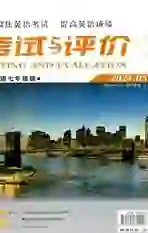Unit 9词语和句型考点归纳
2021-08-14赵广书
赵广书
【词语精讲】
1. tall adj.
tall意为“高的”,既可以指人的身材高,也可以指物体的高度。例如:
He is a tall boy. 他是一个高个的男孩。
The Greens live in a tall building. 格林一家住在一幢高楼里。
【辨析】 墙壁(walls)、山(mountains)一般使用“high”来形容高,high可以表示某物高出地面的距离,其反义词是 low(低)。例如:
Its a very high wall. 這堵墙很高。
Mount Blanc is the highest mountain in Europe. 勃朗峰是欧洲最高的山峰。
【拓展】 height是high的名词形式,意为“高;高度;海拔”等,词组be (of ) medium height意思是“中等身高”,而medium build意思是“中等身材”。例如:
Mary is thin and she is of medium height. 玛丽瘦瘦的,中等身高。
He is a man of strong build. 他是一个体格健壮的男人。
2. heavy adj.
heavy意为“重的”,还可以用来表示雨等“下得大”。例如:
For him, the box is too heavy. 对于他来说,那个箱子太重了。
What a heavy rain it is! 多大的一场雨呀!
3. tonight adv. & n.
tonight意为“(在)今晚;(在)今夜”, 其用法等同于this evening。例如:
I am at home tonight. 今晚我在家。
There is a new movie at Hong Xing cinema tonight. 今天晚上红星电影院有一场新电影。
4. glass n.
(1) glass意为“玻璃”时,是不可数名词。例如:
A lot of things are made of glass. 许多东西是玻璃制成的。
(2) glass意为“玻璃杯”时,是可数名词。例如:
Theres some milk in the glass. 玻璃杯里有一些牛奶。
She broke two glasses. 她打碎了两个玻璃杯。
(3) glasses意为“眼镜”,常用复数形式。例如:
My teacher wears glasses all the year. 我的老师一年到头戴着眼镜。
【友情提示】 cup主要指带有手柄的杯子,如茶杯、咖啡杯等;而glass意为“玻璃杯”,指由玻璃做成的杯子,如喝啤酒用的啤酒杯,喝红酒用的高脚杯等。例如:
They had a chat over a cup of tea. 他们喝茶时聊着天。
Would you like a glass of sherry? 要来一杯雪利酒吗?
5. later adv.
later意为“以后;后来”。例如:
I will come back later. 稍后我会回来的。
【拓展】 later用作形容词时,意为“后期的;较晚的”,是late的比较级。例如:
Im later than yesterday. 我比昨天晚了。
6. handsome adj.
handsome 意为“英俊的”,主要用于男性,但有时也用于女性(一般只用于成年女性,不用于少女),意为“体态健美的;端庄稳重的”。例如:
He is a handsome young man. 他是一个英俊的年轻人。
Do you describe her as beautiful or handsome? 你是说她貌美还是说她健美?
【拓展】 (1) beautiful 表示“美”,可用于人或事物。用于人时,通常只用于形容女性或小孩,一般不用于男性。它表示的“美”主要侧重从客观上表明一种接近理想状态的美,语气很强。例如:
She is a beautiful girl. 她是个美丽的女孩。
Its a beautiful village. 那是个美丽的村庄。
(2) pretty 主要表示“漂亮;俊俏;标致”等,可用于人(主要是女性和小孩)或事物,语气比 beautiful弱。它往往侧重从主观上评述某人或某物,含有“可爱;讨人喜欢”之意。例如:
What a pretty dress!多漂亮的连衣裙啊!
She is not really beautiful, but she looks pretty when she smiles. 她其实长得并不美,但笑起来很好看。
(3) good-looking 意为“好看的”,主要用于人(男人、女人或小孩),有时也可用于事物,但不多见。例如:
He is good-looking. 他长得很帅。
He has a good-looking car. 他有一辆好看的汽车。
7. way n.
way意为“方式;路线”。常用的固定词组有:on the way to... 意为“在去……的路上”;in this way意为“用这种办法”;by the way意为“顺便问一下”。例如:
Im on the way to school. 我在上学的路上。
In this way, you can find your lost key. 用这种办法,你可以找到丢失的钥匙。
By the way, where is the post office? 顺便问一下,邮局在哪里?
8. crime n.
crime意為“犯罪活动”,是可数名词。该词可加后缀派生成另一个名词,即criminal,意为“犯罪分子”。例如:
These people have some crimes. 这些人有犯罪活动。
I dont know the criminal. 我不认识这名犯罪分子。
9. put v.
put意为“放”,其现在分词形式为putting。例如:
The boy puts his book on the desk. 男孩把他的书放在了课桌上。
10. describe v.
describe意为“描述”,侧重指描述细节,给读者或听众提供清晰的视觉图像。例如:
She described the accident very carefully. 她非常仔细地描述了事故。
Could you describe the man for me? 您能给我描述一下那个人吗?
【短语串串】
1. (be) of medium height 中等身高2. (be) of medium build 中等身材3. a little late 有点晚 4. a small mouth 小嘴5. a round face 圆脸 6. in the end 最后7. blonde hair 金黄色的头发8. be good at (doing) sth. 擅长(做)某事 9. go to the movies 去看电影10. a police artist 警务画家11. draw a picture of the criminal 画一幅罪犯图像 12. wear glasses 戴眼镜13. see you later 再见14. tell sb. sth. 告诉某人某事15. (in) the same way (以)同样的方式16. first of all 首先;最重要的是17. have long straight hair 留长直发 18. wear jeans 穿牛仔裤19. on television 在电视上20. put it in the newspaper 把它登在报纸上
【难句在线】
Were meeting at seven, right? 我们将在七点钟见面,是吗?
(1) 此句用现在进行时表示将来,表示按照计划﹑安排将要发生的动作,后常接tomorrow, soon等表示将来的时间状语。能用这种结构表示将来的动词往往是表示位置移动的动词,如come, go, leave, arrive, start, get, stay等。例如:
My good friend Tom is coming to my home soon. 我的好朋友汤姆一会儿要来我家。
They are going to the village tomorrow. 他们明天打算去村庄。
(2) right是一个省略句,其全句为“Is that right?”意为“对吗;是吧”,一般用来表示对当前陈述内容进行确认或核实。例如:
—We dont have lessons this afternoon. Is that right / Right? 我们下午没有课,对吗?
—Of course. 当然。
注意:在口语中经常使用省略句子来表达意见或想法。
